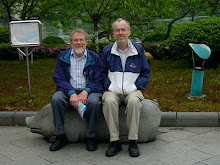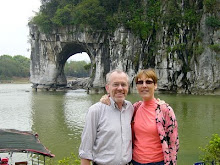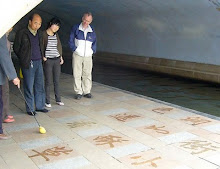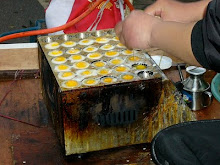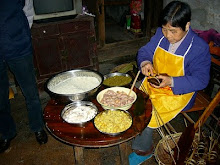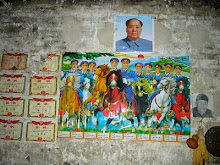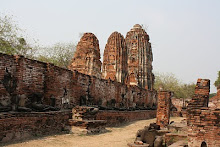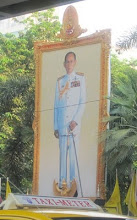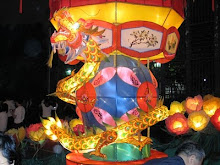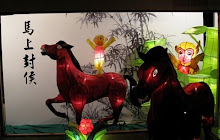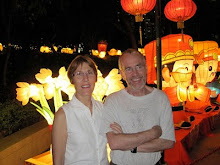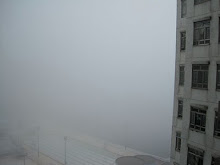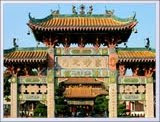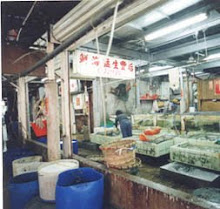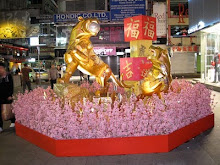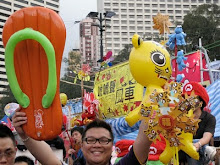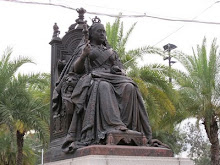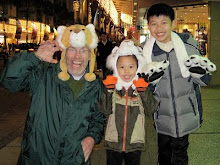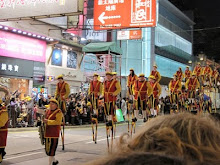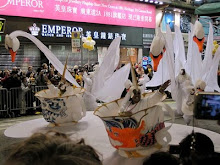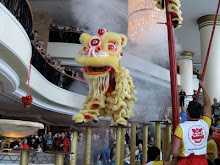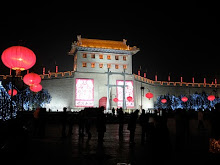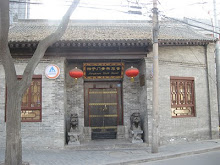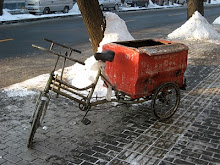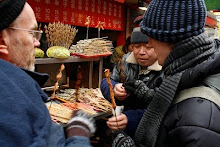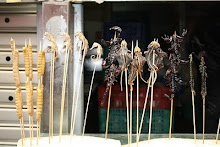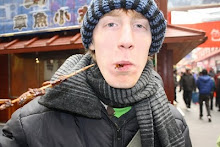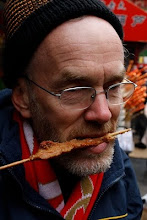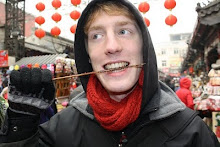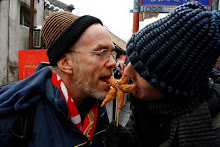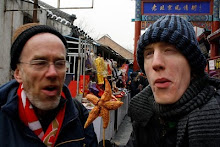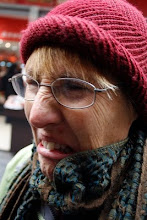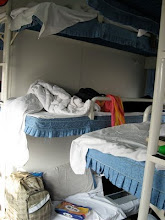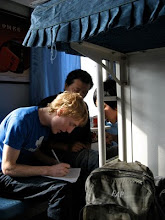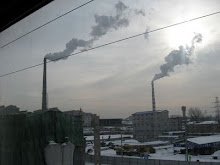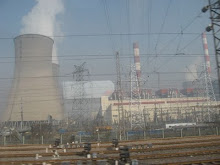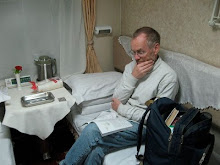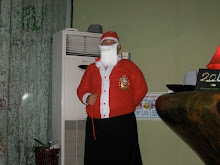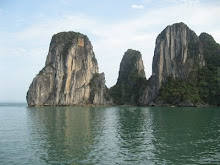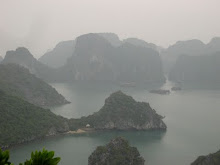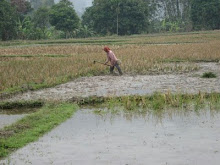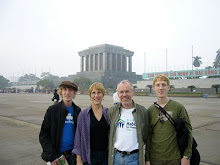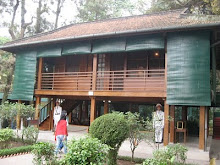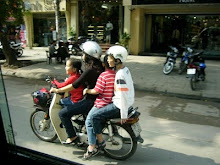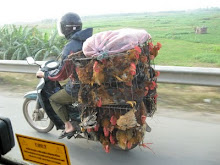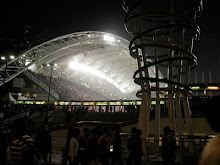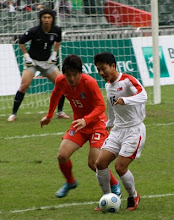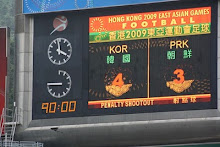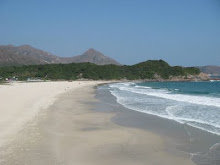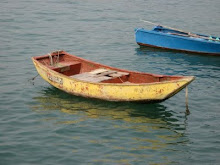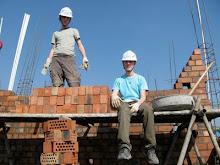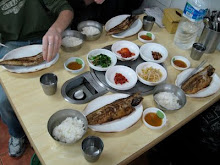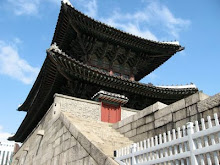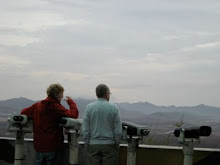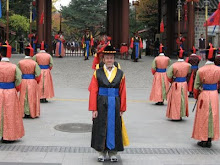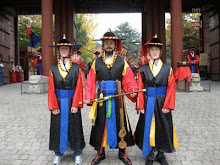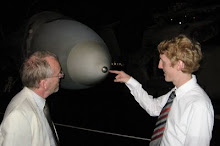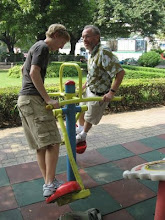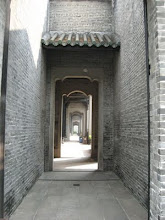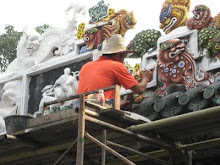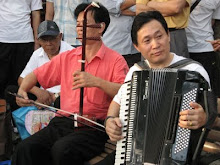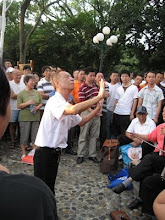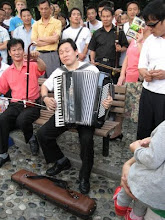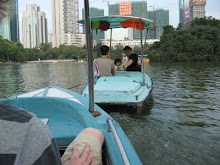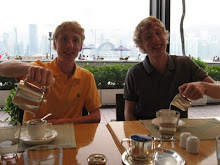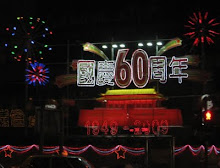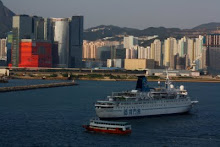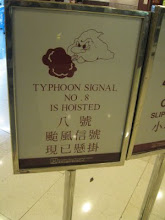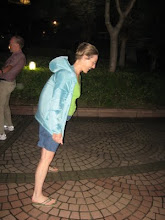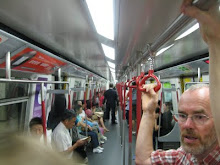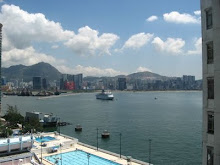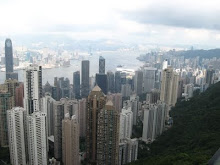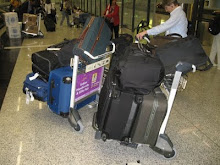Tuesday, July 6, 2010
It has been a long time since I have written anything for this blog. This is not, of course, because my life has become boring and I have nothing to say, but rather because I have been rather busy with not enough time to think about things let alone write about them. Actually, that is not true, I am thinking about things quite a lot, but now mostly from the perspective that this big adventure is finite in time and will be over all too soon.
In fact, as I write, I am sitting alone in our apartment, with a beautiful breeze blowing in through the window. Both things are unusual, in fact I should probably go out and take some pictures because the wind has brought a rare clarity to the air and the lights from the buildings across the harbor could be captured well. But the alone part is because Jacob and Duncan left about 10 days ago and Elizabeth also set put on her travels last week. We bought round the world tickets to get here and home and so they are utilizing them well. Elizabeth has a Japan/Denmark/Italy/England/USA plan and Duncan and Jacob are visiting Germany/Finland/Italy/England/USA. You will note the overlap of the latter parts and I will be joining them in Italy in 2 weeks time. I get to travel less than everybody else because I have a commitment to work here for 10 months and so cannot leave until mid-June.
I did a workshop today at Shue Yan University, a private institution here in Hong Kong. There were 4 of us general education Fulbrighters there and apart from noticing how easily and well we work together, it was also clear that this was one of the last times that we were going to be doing so. We all are going back to our regular jobs by different routes and at different times, but I am not sure that any of us are looking forward to it. Life here, both professionally and socially/culturally is so exciting, interesting, fast-paced, ever-eventful and just plain damn fun, that nothing is likely to measure up. Perhaps inevitably, a passage of your life where you get to go off and do something different in another place for a limited amount of time is going to be more interesting than the routine, but here that has been taken to another degree. Firstly the project itself is of enormous scale and significance. The education system in Hong Kong is attempting to reinvent itself in a very courageous and far-reaching way. To have the opportunity to assist with such a transformation is rare. Of course, it can also be frustrating and feel like it's going nowhere, but even that is much easier to deal with when it is not your institution and that it really is up to others to make the decisions. Ten months is actually a good length of time, because it allows us to really get to understand what is going on here and make some useful contributions, but still permits us to be external, neutral and not partisan in the struggles that inevitably surround changes of this magnitude. Another important part about it is that do get to work as a team. It is an excellent way to work. - we learn from each other, spark ideas off each other, lend a ready ear when we are trying to figure out what is going on around us and are also good playmates. I guess on the larger scale of things we are rather similar and are all very enthusiastic about general education. But we also have our diversity, which contributes to the overall level of thinking. In fact, the level of discourse on the general/liberal education topic that can be had with this group is probably as high as you are going to find anywhere.
So the work has been wonderful but then Hong Kong has to be one of the most exciting places on earth, especially in comparison to rural Connecticut. I am not knocking Connecticut and there are aspects of it that I am eagerly anticipating (cool, crisp mornings, peace and quite, relatively clean air). But there are several fold more people in the housing development in which I live than there are in my home town. And this one is not particularly big by Hong Kong standards. I see more people on my walk to work in the morning than I do in a whole day back home. I am not going to talk about the food here, except to say that it is exceptional in terms of variety, availability, cheapness (if you go to the right places) and all round excellence (if you go to the right places and sometimes they are the same ones as in the previous phrase). Public transport, arts events, the ability to get out of the city in well under an hour, Premier League soccer on TV - the list could go on and on. Of course, there are downsides - just think of the inverse of the things I am looking forward to in Connecticut, but now is not the time to dwell on them.
Early July
I never quite go to post that last entry. Too many things to do in HK befo re I left and them limited internet access afterwards. A good period of time in Italy and England certainly made leaving Hong Kong easier, though it remains to see how it will be to reenter Connecticut.I I could write about World Cup and Wimbledon and weddings, but that somehow seems quite separate from Hong Kong and this blog. Except perhaps the World Cup, since many in HK are very involved in that. The day before I left, I visited one of the plusher malls and watched half of the Slovenia/Algeria game. Very big screen TVs, miniature mock stadiums, special promotions in all the stores. Ah for Hong Kong! I suspect they were more upset when England was knocked out than many here.
Wednesday, April 14, 2010
Pak's gastronomic excursions always have settings and this one was to occur in East Mongkok, in the neighborhood of the goldfish market. When he was younger, he had gone there regularly to buy fish. There are lots and lots of small stores selling innumerable, magically colored varieties of fish, plus all the required accoutrements.
It is in a relatively run-down neighborhood and so perfect for good cheap restaurants.
Pak decided that, since it was the 15th and many people would be avoiding meat, we should go to the vegetarian restaurant first before it got too crowded. Unfortunately, when we got there, we discovered that the restaurant had changed and was now heavily centered on meat. We decided to move on to Pak's second choice, which focused on food from Yunnan Province. But that also no longer existed. This is not an uncommon occurrence in Hong Kong, where restaurants change with great rapidity. So we crossed the road to eat at a dumpling restaurant.
It turned out that it was part of a chain, a Chinese variety of fast food. They sold about five different kinds of dumplings that could be had boiled or fried. You selected one or two kinds of dumpling and combined it one of five kinds of soup. Very simple and formulaic, but very tasty also. I had hot and sour soup for the first time in Hong Kong. All of the dumplings had meat in them, but Pak had decided that he had met his religious obligations by searching out the other restaurants. He could not be blamed for the fact that they no longer existed and he was being forced to eat meat.
There were several elements of the dumpling restaurant that interested me and can be contrasted with US fast food. First, one of the employees was sitting there, busily stuffing and folding dumplings. We asked her where the wrappers came from and found they were made at their central facility. In the US, everything would be made at the central facility and delivered frozen to the outlet. Then the serving dishes, plates, bowls everything were real china or plastic, nothing disposable. It's often difficult even to get a napkin in a restaurant here, but that's another story. The chopsticks, spoons and small bowls were kept in drawers within the tables; you just open up and take out what you need.
Having finished lunch proper, it was time to search out the stinky tofu restaurant. Part of me was hoping that it would have met the same fate as the other restaurants, but soon I could tell that was not the case. The unmistakable odor became apparent amidst all the other street smells. It grew stronger and stronger until we reached the storefront. It seemed like they had a variety of things available, including sausages and animal parts, but we were single-minded. For HK$6 (less than a buck) I got a brown paper bag containing a 2 inch cube of the magic stuff on a stick. It had been deep-fried a toasty golden brown. By this time, we had started to become accustomed to the smell. Texturally, this food is good. A nice crunch to the outside, with soft and creamy inner parts. Unfortunately it tasted just like it smelled and as I started to eat it, the taste and smell combined synergistically in a rather unpleasant way. Fortunately there were several condiments available, both sweet and savory. I found that the hot sauce was pretty effective for masking the flavor, though it could not override the smell. Pak assured me that I was not required to finish the whole thing. I heartily agreed with him and jettisoned the rest of it in a handy garbage can.
I asked Pak why people ate it; did it have some perceived medicinal benefit? He said no, it was just that some people liked to live on the wild side. Stinky tofu is outside of normal behavior and consumed by people who like to be a little outrageous. I have a wide definition of food, but this was a little much for me. The soft inside part was full of gas bubbles from active fermentation. No wonder the smell was so powerful. I wondered which bacteria were responsible and hoped that they had all been killed by the frying process
We had agreed that this was to be a three-part adventure so now we went in search of Chinese dessert. As I said, Pak always has something in mind and he was looking for something in particular here. He found it, with a little directional help from some street vendors, - the Yee Shun Milk Company. I had seen these places before, though never been in. Their windows are filled with dishes of various puddings/custards. Milk-based puddings did not seem very Chinese to me, but apparently these places, which originated in Macau, have been around a long time. But they definitely represent a fusion between East and West. The menu also included fried eggs and sausage and sandwiches. But we were after desert. We both got steamed milk; Pak's was flavored with ginger. I thought of it as something you might be fed in a British convalescent home. Very nutritious with all those milk and egg proteins but easy to get down. It was softly set, nicely flavored and not too sweet; the perfect antidote to stinky tofu.
Friday, April 9, 2010
Touring China
My brother Stuart and his wife, Corky came to visit us in Hong Kong. Stuart has recently retired and so they took the opportunity to come here and then travel through China. Their trip through China was organized through a tour company and we joined them for the first leg of the trip, to Guilin in southern China. It was interesting to compare this kind of traveling with the youth hostel, figure it out on the fly approach we used for our last big trip to China.
This kind of touring was not the busload of gawking foreigners approach. It just meant that we had a guide and a driver, with accommodation and meals arranged.
At our suggestion, the first leg of the trip to Guilin was by train, so that S&C could experience first hand this kind of travel in China. Its interest started the week before they got here, when the tour company emailed Stuart to say they had been unable to get soft sleeper tickets originating in Shenzhen (just across the border from HK) and could we start from Guangzhou instead. That's just a 2 hour train ride up from HK and so not difficult, but what is interesting about it is that the train we could not get on in Shenzhen was exactly the same train we ultimately did board in Guangzhou. So our soft sleeper berth went from Shenzhen to Guangzhou empty, while we followed the same route on a different train. I assume it is something to do with ticket quotas available in different towns.
Having a guide and driver available is something that I could get used to. It is feasible, even for a small party, because wage rates in China are relatively low. With our lack of Mandarin, there is always so much we miss when traveling in China and so here we always had somebody to whom questions could be addressed. Of course, you have to bear in mind that you are getting one person's version of the world so statements have to be interpreted with caution. But S&C had done their homework well and selected good and interesting places to visit and we were delivered to them with great efficiency and ease.
The area is very touristy but with good reason. A lot of those classical pen and ink Chinese paintings are from here, with the limestone karsts rising vertically and spectacularly out of the otherwise flat landscape. Absolutely beautiful, but a little too touristy for me, especially Yangshuo. Except for the Chinese characters on the buildings, I felt like I could have been just about anywhere (e.g. the White Mountains of New Hampshire. The landscape was different but the tourist pedestrian street was the same. But actually, it did not take too much scratching beneath the surface to find the differences. I always like to get to the food markets in these places and this one was easy to find, in a large single storey building just off the main street. There was a sign close to the entrance, interestingly in English as well as Chinese, advertising a restaurant serving dog meat. And there, buried in the back of the market, alongside the live chickens and ducks and rabbits, were the dogs. I first caught sight of one whose throat had just been slit and was bleeding out. That was right next to several cages with light colored mongrel dogs. One of the things our guide had told us was that people think light furred dogs taste better than dark colored ones. Seems unlikely, but who knows? I ate dog meat in Beijing, but that was cooked on a stick and quite different from seeing the animals being killed up close. I am not sure for me whether it was any different from seeing a sheep or a pig have its throat cut. Getting that close to the reality of being a meat eater is never easy, but I think quite useful.
On the subject of food, the downside of being on the hands of the tour company was the places they took us to eat. The hotels are safer from several perspectives and are happy to bill the tour company. But the food reminded me of the kind you get at generic Chinese restaurants on the West. And despite going to different restaurants, they get serving us the same food (corn soup, beef with onions and peppers, egg fried rice). It came to a head quite hilariously when we were served French fries, though with that funny sweet sauce they often serve with the prawn crackers at the beginning of Chinese meals in the USA, rather than ketchup. After that, we did manage to impress on the guide that we would like more interesting food and it did get better.
It was eye-opening to be traveling with Corky, who has both balance and endurance issues and cannot walk far or climb stairs easily. Neither China or Hong Kong is set up well for people with disabilities and it took us all some time to figure out good ways of dealing with it.
We were in Guilin/Yangshuo for 4 days before S&C took off for Shanghai/Xi'an/Beijing and we took the train back to Shenzhen. That was an interesting coda to the trip. We had been thinking we would just get the train tickets from the tour guide and make our own way to the station. But he seemed to want to take us there and so we arranged to meet him at a downtown hotel an hour before the train was due to leave. We arrived at the station and he dropped us off at the entrance for soft-sleeper passengers (yeh, for the class system of Chinese train travel!) while he went to get the tickets. He came back to tell us that we would be getting the tickets on the train. A strange idea to us that also meant we were barred from the soft sleeper waiting area. We were taken to another waiting area where we met the tour agency's train ticket guy. He looked just like the sort of person who would be touting tickets outside sporting venues in the USA, where you would worry whether the tickets you might buy were legitimate. He did not speak English (at least to us) but the guide told us that all the tickets to Shenzhen were sold out, but this man knew how to buy them on the train. There were always some available from the train staff and we would have no problem. It was fascinating to watch the ticket guy working. His eyes were always flitting around, sizing up the situation. Certain individuals would be selected as being important (e.g. a policeman) and he would sidle up and engage them in conversation. Part of the ritual was to offer a cigarette that would be stored for later use.
At a certain point, we were given the sign and walked quickly through to the platform, at the head of the line. Magically, nobody asked to see our tickets. The person in charge of the train was quickly located, given a cigarette, and we were invited to wait in the dining car of the train. After a while, another train person came and sold our guy two soft sleeper tickets. They were in car 2, which seemed unusual since the soft sleeper carriages are usually in the middle of the train, close to the dining car. We were delivered to our berths and the guide and ticket guy took their leave. We were the only people in the entire carriage, which also appeared to lack some of the attributes of the typical soft sleeper, e.g. carpet on the floor in the corridor. It turned out that we were being housed in the train's staff quarters. A mother and child came to share our compartment, but everybody else was train personnel. I think we had been sold empty slots rather than taking somebody's bed, but I have no idea who got the money. So it worked out fine in the end. Actually much quieter and more peaceful than the average Chinese train trip. I suppose it also shows the advantage of using tour companies. We would never have gotten on to that train without them.
Tuesday, March 16, 2010
I am in the middle of a busy patch of workshops and lectures at the moment, but before that we went to Thailand for an extended weekend. The visit was facilitated by Harold Furr, ex of UConn and soon to be ex of Mahidol University just outside Bangkok, where he has been working at their Institute of Nutrition. I gave a talk on zinc to the faculty and grad students there. I don't think he is looking for a job, but if you ever want a tour guide, Harold did a wonderful job of welcoming us and laying out options for various things that we might do.
We flew to Bangkok on Sri Lanka Air - we had not heard of it either but I discovered a wonderful package including 4 nights hotel for about $250 each. The flights were fine, as were the hotels. It may a little tricky getting used to flying in the US again. The flight to Bangkok was a little over 2 hours but we got a full meal and I even ate most of it.
Within about 3 hours of landing in Bangkok, we were all having massages. It is an omnipresent cottage industry. There must have been 30 different places within 5 minutes walk of our hotel. I started out with a Thai massage. I was dressed in pajamas, lying on back and front and the massage therapist came at me using all parts of her body to gain mechanical advantage. So lots of elbows and forearms in addition to hands and she was quite happy to sit on me or alongside me - whatever made sense for the kind of manipulation. Sometimes a little intense but basically very good. Other nights I had a foot massage. A little more relaxing and less full contact, focusing below the knees, but then including the arms and hands, shoulders and head at the end. We ended up going back to the same place almost every night. Either kind of massage cost 200 baht, which is a little more than US$6. The one night we did not go there was because Duncan and Elizabeth decided to get adventurous and went for the fish nibbling feet massage. You put your feet in a fish tank for 15 minutes and the little critters nibble off your dead skin. It sounded altogether too ticklish to me so I did not try it.
Bangkok is a big city but totally different from Hong Kong. It has space to grow out and so it has not needed to grow up. It has relatively few tall buildings, but getting around can be tricky, given the distances involved. There are two skytrain lines and also a couple of subway lines, but their coverage is limited. Most people have to use the streets and so they are very congested. Taxis are good and cheap and brightly colored. We were delighted to ride in from the airport in a bright pink taxi.
Bright colors are a continuing theme, particularly evident in the temples. I think they take their Buddhism fairly seriously in Thailand, or at least as seriously as they take anything. It is apparently somewhat different from the Chinese Taoist/Confucian variety and incorporates more Hindu elements. In fact, in addition to the innumerable buddhas, there were many god statues, some complete with multiple limbs, trunks, etc. One day we went on a tour to Ayutthaya, the old capital. Our guide was very good and he pointed out three different ordination ceremonies where people were becoming monks. Apparently most men in Thailand become a monk for a while one of more times in their lives. Ayutthaya was an amazing ruin on an impressive scale. Early European travelers there described it as far in advance of London or Paris. Unfortunately, a Burmese invasion put paid to it and the capital was reestablished in Bangkok.
Another thing that interested me about Thailand was how unashamedly monarchist they appeared to be. The king is referred to as His Majesty, with big portraits everywhere. There were many parallels with my home country. Both have very long serving monarchs in their 80s, who have been on the throne for almost 60 years. Both have crown princes, with significantly less popularity. Both are really just figureheads, with real political power resting elsewhere. It seemed to me that the Thai king is more genuinely popular and probably better connected to his people. A little more active and involved and less aloof.
Things were disturbed politically while we were there by the decision from the Supreme Court to confiscate a large part of the resources of the ex-premier, Thaksin, who was deposed by the military, I think 3 years ago. Military coups are a bad idea, but this court case seemed pretty clear as he was making billions from the telecommunications industry while he was prime minister. Despite his corruption he remains very popular with the rural people and so they, the so-called redshirts, are protesting and demonstrating and demanding that the government step down. Apparently, their party has won every election in recent memory. Fortunately for us, they took a few days to get organized and so it is happening now rather than when we were there.
It would seem almost sinful to not say something about the food and the markets, since they are such important and enjoyable features. But I think I have written long enough, so if you want to know more, drop me an email and ask.
Wednesday, March 3, 2010
You can get excellent food in malls in Hong Kong. I had sort of been aware that good restaurants could be located in malls. Ground floor shop front space is in short supply, so restaurants often set themselves up elsewhere. But last Saturday, we went to see Precious and decided to go look for dessert as part of our attempt to process what we had seen. The theater was about a 10-minute walk from a big ritzy mall so that was where we headed. The mall, Langham Place, is architecturally very interesting. It is spread over 12 floors and has some wonderful open areas that allow you to look down through most of those indoors. I don't think it can be very "green" - it must take a lot of energy to cool that volume of air. It also has some very long escalators, which means that you can get up 12 floors in 3 flights. Anyway, to get back to the food, we toured the mall in search of dessert, but also noticed the crowds of people, at 10.30 PM, sitting and eating dinner. There were lots of different kinds of food and all of it looked good. Actually, I am sure there must have been a McDonalds there also, so perhaps that was an overstatement. We ended up at a Japanese/Western fusion restaurant on the 11th floor and enjoyed delicious and unusual desserts. The mall did start to close around 11 PM, much later, of course, than those in most US cities.
A snowstorm would feel pretty good right now. For the past week or so, the temperatures have been in the mid to high 70's and the air has been as wet as it can get. Warm fog is a new phenomenon for me, but visibility quite often has been down to about 50 yards. The great view that we have out across Victoria Harbour has been reduced to gray, and boat foghorns have been added to the background noises. We had been washing our clothes in our machine and then hanging them to dry, because we don't have a drier. That doesn't work any more because they just don't dry. So now we have to take them to the laundry. Elizabeth and I realized that the dirty smudges on the wallpaper in our bedroom were actually healthy (or rather unhealthy) growths of mould. Fortunately, the wallpaper was washable, so that was what we did. Also fortunately, it was warm enough to turn on the air conditioner and use it to dry out the room.
I had been thinking that Hong Kongers were lousy pedestrians, because I keep having to adjust my direction to avoid them as I move at my faster than average pace. In fact, I think they are just average pedestrians, although they do walk a lot more than the average Western city dweller. My collision avoidance tactics are required simply because the density of people is so high that there is very little space between us. It’s a bit like driving a car in London, where you have to get used to negotiating narrow spaces with very little clearance.
Here is my final difference for today. This afternoon I met with the director of Hong Kong Community College, which is affiliated with PolyU. Hong Kong has community colleges, just like the US, to give opportunity to those who cannot attend a university. However, here it costs more to attend community college than one of the state-sponsored universities. I think about 16% of high school leavers can find a place at one of the 8 government funded universities. For those that cannot get in and don't have the resources to go abroad, there are local private full degree colleges and there are these 2 year institutions. Community college students here are mostly school leavers, attend full time, and evening and weekend classes are not offered. And at least for HKCC graduates, they transfer into full degree institutions at a very high rate.
Wednesday, February 24, 2010
Actually, the Funfest was the second event of the day because first we went for dim sum, Shanghai style, with Alex and Elaine, two HK friends. Normally we have Cantonese dim sum and that style is relatively plain and simple, allowing the quality of the ingredients to shine through. The Shanghai version was more complex and spicier. A noodle soup with a rich peanut broth, steamed dumplings that magically contained soup in addition to the expected pork. It helped that Alex and Elaine knew what they were going for and could read the menu. It set us up well for the horseless festival.
From Shatin, Alex drove us across the New Territories to Tuen Mun and the Tsing Chung Koon Taoist temple that contained photographs of his godparents. I realize that I do not understand exactly what godparents are in Chinese terms, but honoring ancestors is a very important part of this culture. So having a place where you can go and connect with them is very important. He bought incense sticks on the way in and then both he and Elaine would light a few at a time and present them to the photographs. No actual bodies or ashes were there. They lit some on behalf of themselves and then some for their son, Gary, and then others were presented to the neighboring photos, to keep them happy too. I think there is a sense that of you are good to your ancestors, they will be good to you too. Another important way that people make offerings is to burn stuff, for example bags of fake money. There are stores where you can go and buy all sorts of paper objects - houses, cars, clothes - anything that a person might need in the afterlife. The temple has big ovens to burn these objects, although often you can see people just burning them in the street also.
The temple complex was large, with several buildings including an old peoples' home and a free Chinese medicine clinic. There were nice gardens too, with a pond full of turtles.
We moved on from there to briefly visit the visitor center for the Ping Shan Heritage Trail, a set of walled villages, temples etc., but then we needed to pick up Jacob and Duncan who had spent their day working as English teachers at Mr. Brown's English Highway. We also rendezvoused with Elaine's sister and her husband who also brought Gary. Our two-car convoy then drove off to find the oyster capital of Hong Kong, Lau Fau Shan. We perused the market there thoroughly, and then made our selection of seafood and restaurant. It was a spectacular feast, a large section of an enormous fish that we watched meet its end, cooked two different ways, clams, crabs and then the oysters, either, or I should say both, deep fired in a light batter or sautéed with ginger and garlic. There was a lot more, of course, but these were the memorable bits.
This posting is rather light on photos, I am afraid - J&D were not present for most of it and then E's camera had a battery problem.
Thursday, February 18, 2010
Kung Hei Fat Choi is the standard CNY greeting. Best wishes and prosperity. CNY is mostly a family affair, which of course did not involve us. People travel to see their parents and grandparents. The train stations in China got even more crowded as this is one time when you feel that you really have to go. I think this is a few levels beyond the US Thanksgiving obligations. The schools are closed for a week here, although I am expected back at work on Wednesday, so the weekend plus 2 days for me. We followed our normal practice of experiencing everything that we could.
One of the nicest parts is all the flowers. There are lots of flower markets set up several days before hand. One of the biggest is in Victoria Park and so that is where we went. The flowers were gorgeous - lots of gladioli and chrysanthemums and then more specifically Chinese variants - peach and plum blossoms and then small or not so small tangerine (or related citrus) trees. They also have small daffodils that you want to buy closed so that they will open on New Years Day and bring you the most luck. There were many, many flower vendors doing a good trade, but then there were even more stalls selling all manner of junk. HK is the capital of junk and of commercialism and it was out in full force. Tigers made out of everything to fit all parts of your body and to perform all functions. Lots of fair food, some familiar and some not so.
Actually, I have to say, for me CNY food has been something of a disappointment. They have these rice flour cakes, flavored with brown sugar or turnips or carrots. They are extremely gelatinous and not very sweet - in fact sometimes they are savory, with added fish or bacon flavorings. You buy them as circular cakes, slice them, dip them in egg and fry them. Given the numbers of them sold, they must be very popular here, but all I can say is, there is a good reason that most cultures in the world bake with flour made from wheat rather than rice.
Putting aside baking, the Chinese certainly know how to throw a parade. The HK New Year Parade was one of the best I have ever seen. It was certainly the most international. There were fireman gymnasts from France (performing in their fire-fighting gear), flag throwers from Italy, stilt walkers (some ridiculously high) from Belgium, steel drums and puppets from the Notting Hill Carnival, Russian dancers, US cheerleaders (yes, that was a little disappointing) and then, of course participants from all over Asia. Lion dancers and dragon dancers, and dancers of many other kinds, lots of bands, and big commercial floats of varying degrees of creativity. More than 100,000 people come out to watch it so we had to get there early and wait almost 2 hours for the parade to get to us. Actually, it was the first parade that I have ever been to where there was a pre-parade - a Scottish/Hong Kong bagpipe band did a couple of circuits to keep us entertained while waiting.
That was the evening of the first day of the CNY and then the second evening was the fireworks. There have been a few other firework opportunities here, but we have never really seen them at their best. This time we (well at least Jacob and Duncan and I) decided we were going to do whatever it took, so we got ourselves down to the best viewing area, the Avenue of the Stars on the waterfront, about 2.5 hours before they started. We took our first waiting position in a convenient Starbucks (must have one of the best views of all Starbucks). We went and took up position opposite the firework barges with about 1.25 h to go, and the time went pretty fast as we shared stories of our youth. The fireworks were very impressive. They seem to specialize in pictoral displays. So along with the valentine hearts, we had lots of tiger faces, smiley faces, 8s (very lucky) and Chinese characters. We were close enough so we could feel the explosions as well as see and hear them.
We also had a couple of other good close up CNY experiences. Some friends told us that a lion dance company were going to perform in the lobby of a nearby hotel on the morning of CNY Day. They were spectacular - 2 men to a lion, jumping all over the lobby. And then the Notting Hill Carnival group came and performed alongside our Whampoa ship on Tuesday. They were quite foreign in the local context, black-skinned people playing steel drums with great exuberance. Nicely familiar for me, though. And at the end a couple of band members came to greet me because they noticed my Arsenal scarf and wanted to say hi to a fellow supporter.
One other interesting custom is the giving of red packets, small envelopes containing just a little money. Most of the ones I have given contain HK$20 (about 3 US bucks). They go to friends who are younger than you and unmarried and to people that perform services for you, e.g. the security guards and janitors in our apartment complex. The $$ amount is less important than the well wishes and the associated good fortune for the coming year.

